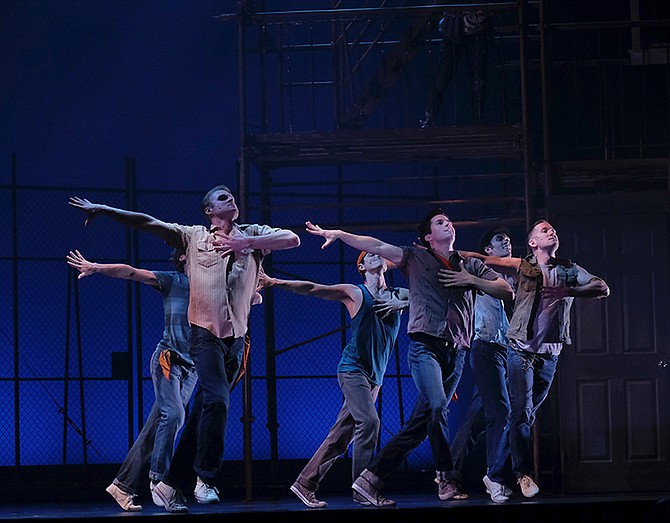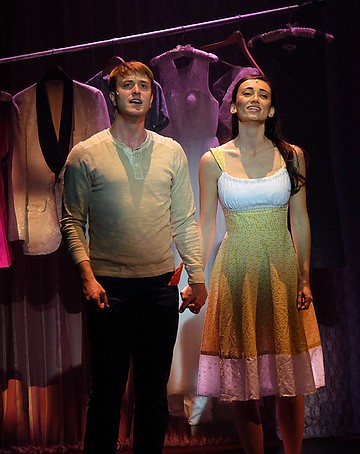 Facebook
Facebook
 X
X
 Instagram
Instagram
 TikTok
TikTok
 Youtube
Youtube

On the difficulty of making a musical, Brooks Atkinson wrote: “No one would undertake the intricate, painful, gargantuan, hysterical task… unless he had more enthusiasm than most people have about anything.”
Imagine a musical conceived like no other: base it on a classic tragedy; weave the book, music, and choreography so tightly they become one; and (maybe the most ambitious at the time) cast performers who can sing, act, and dance. And not just dance, but move with the speed and athletic grace of ballet.
Now combine savvy pros Jerome Robbins (direction and choreography) and Leonard Bernstein (music) with relative newcomers Arthur Laurents (book) and Stephen Sondheim (lyrics) and what could have been ego-friction becomes one of American musical theater’s greatest fusions.
West Side Story was amazing when it opened in 1957. And amazes today at the Spreckels Theatre.
The musical’s staged so rarely because it’s one of those “get it right or else” favorites. To lovers of the genre, it’s lodged in their genetic code. Tony has to sing “Something’s Coming” and “Maria” beautifully, right off the bat, or else. He and Maria must create audience lift-off with “Tonight” and “One Hand, One Heart,” or the aisles will empty. Same for Anita’s sassy “America,” and for the non-stop, insane kinetics of what Robbins called “ballet d’action.” In other words, the stage picture must kaleidoscope all the time. Effortlessly.

The SDMT production gets all plusses on the checklist. For years, Jacob Caltrider has done fine work in supporting roles. He is excellent as Tony (the OG, “original gangsta” whose old-school ways cause tragedy). Give this young superbly talented man more lead roles!
Jessica Soza, vocally and physically, makes for a fine match to Caltrider’s Tony. And their duets are splendid. Leonard Bernstein might object to some of their more operatic deliveries (He told Carol Lawrence, the first Maria, he didn’t want opera: “Sing it from your heart. I don’t want pear-shaped tones”), but probably wouldn’t for long.
West Side Story is based on Shakespeare’s Romeo and Juliet, but with a difference. In the musical, Juliet (Maria) lives and delivers a monologue so powerful that Bernstein couldn’t write her a song (“I never had an experience like that. Everything sounded wrong”).
Natalie Nucci’s Anita has just the right pizzazz, and though there are times when Jeffrey Scott Parsons indicates a tough attitude as Riff, he delivers the goods as West Side’s answer to Mercutio. Manny Fernandes leads a huge supporting cast as Lt. Schrank, xenophobe extraordinaire.
Miles of credit to director James Vasquez, choreographer Randy Slovacek, and music director Don Le Master for the life that leaps from the stage, and for the intricate coordination behind it.
And also to Sean Fanning’s slender, sturdy, monkey-bar-like set and Amanda Zieves’ piercing shafts of light and bold, Rothko-esque hues on the scrim.
Robbins, Bernstein, Laurents, and Sondheim were a perfect fit. San Diego Musical Theatre and the Spreckels look like one as well.


On the difficulty of making a musical, Brooks Atkinson wrote: “No one would undertake the intricate, painful, gargantuan, hysterical task… unless he had more enthusiasm than most people have about anything.”
Imagine a musical conceived like no other: base it on a classic tragedy; weave the book, music, and choreography so tightly they become one; and (maybe the most ambitious at the time) cast performers who can sing, act, and dance. And not just dance, but move with the speed and athletic grace of ballet.
Now combine savvy pros Jerome Robbins (direction and choreography) and Leonard Bernstein (music) with relative newcomers Arthur Laurents (book) and Stephen Sondheim (lyrics) and what could have been ego-friction becomes one of American musical theater’s greatest fusions.
West Side Story was amazing when it opened in 1957. And amazes today at the Spreckels Theatre.
The musical’s staged so rarely because it’s one of those “get it right or else” favorites. To lovers of the genre, it’s lodged in their genetic code. Tony has to sing “Something’s Coming” and “Maria” beautifully, right off the bat, or else. He and Maria must create audience lift-off with “Tonight” and “One Hand, One Heart,” or the aisles will empty. Same for Anita’s sassy “America,” and for the non-stop, insane kinetics of what Robbins called “ballet d’action.” In other words, the stage picture must kaleidoscope all the time. Effortlessly.

The SDMT production gets all plusses on the checklist. For years, Jacob Caltrider has done fine work in supporting roles. He is excellent as Tony (the OG, “original gangsta” whose old-school ways cause tragedy). Give this young superbly talented man more lead roles!
Jessica Soza, vocally and physically, makes for a fine match to Caltrider’s Tony. And their duets are splendid. Leonard Bernstein might object to some of their more operatic deliveries (He told Carol Lawrence, the first Maria, he didn’t want opera: “Sing it from your heart. I don’t want pear-shaped tones”), but probably wouldn’t for long.
West Side Story is based on Shakespeare’s Romeo and Juliet, but with a difference. In the musical, Juliet (Maria) lives and delivers a monologue so powerful that Bernstein couldn’t write her a song (“I never had an experience like that. Everything sounded wrong”).
Natalie Nucci’s Anita has just the right pizzazz, and though there are times when Jeffrey Scott Parsons indicates a tough attitude as Riff, he delivers the goods as West Side’s answer to Mercutio. Manny Fernandes leads a huge supporting cast as Lt. Schrank, xenophobe extraordinaire.
Miles of credit to director James Vasquez, choreographer Randy Slovacek, and music director Don Le Master for the life that leaps from the stage, and for the intricate coordination behind it.
And also to Sean Fanning’s slender, sturdy, monkey-bar-like set and Amanda Zieves’ piercing shafts of light and bold, Rothko-esque hues on the scrim.
Robbins, Bernstein, Laurents, and Sondheim were a perfect fit. San Diego Musical Theatre and the Spreckels look like one as well.
Comments